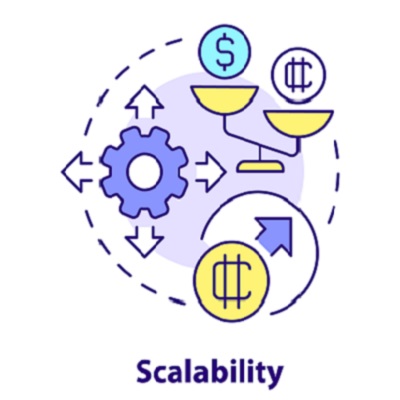A move beyond traditional budgeting does not necessarily mean losing the budget. Rather, it’s important to...
Scaling has become a “buzzword” in business that can be misunderstood. We’ve decided it’s important for our financial planning and analysis (FP&A) professionals to understand scaling to help with strategic recommendations to our leaders.
For example, when we talk to our business leaders about the annual budget, they must understand what achieving scale means. By designing activities that lead to scale, we can achieve the necessary returns to capital and simultaneously create re-investment in the business that results in more fantastic career paths for employees. It’s a way to win-win for everyone in the company.
Understanding Scalability
According to Investopedia, scalability refers to an organisation’s ability to grow without being hampered by its structure or available resources when faced with increased production. This concept is closely related to the term economies of scale, in which a company can reduce its production costs and increase profitability when it produces more of a given product. In effect, it is spreading production costs over more units, making each of them less expensive to produce. By contrast, increased production leads to more significant costs and lower profits, known as diseconomies of scale. With certain activities, diseconomies of scale may be more relevant than you think and identifying these areas can help with strategic plans.
Concerning scaling, I have been reflecting on our experience with how we prepare annual budgets. Ten years ago, I did my first merger due diligence and integration. As we prepared the Pro-forma with five-year P&L projections detailing integration costs and synergies, we were projecting economies of scale with growth. I have learned that we always expect to obtain economies as the primary reasons of scale in our projections for potential acquisitions as opposed to diseconomies of scale, which is one of the reasons (along with talent recruiting) we make acquisitions in the first place.
Creating Scalable Budgets
A year after my first merger due diligence, I was in charge of my first Regional budget. We did ground-up budgeting, looking client by client, person by person, and expense and expense. As we rolled the budget up, the consolidation was not close to the desired capital returns. While we knew every single transaction, we failed to translate how the interactions of those transactions created a scale and, more importantly, economies of scale. Trying to find additional dollars to hit the required returns, we “squeezed” operations with plugs without a strategic plan to execute. It baffled me that we did not do the same strategic analysis with our existing operations that we were performing on mergers and acquisitions. Furthermore, if we had specific activities that were creating diseconomies of scale, they could only grow with additional resources. We might have been trying to subsidise those activities with allocations from other functions (robbing Peter to pay Paul), which ultimately stalls growth!
From that point forward, I switched to using the same mergers and acquisition template to perform my annual budgets, enabling all of our budgets to tell a better story of what we want to invest in versus divest, resulting in superior performance. At the beginning of each budget cycle, we pick an organic growth revenue target and other key efficiency metrics, like new and lost business, we expect to achieve by executing key strategies. Integration costs are similar to investments, expecting a return. Synergies come from teams doing more together than they could as individuals, particularly in products with high-demand to customers. We discuss the tradeoffs we are willing to make to hit our numbers and the available levers if revenue underperforms. The compensation ratio needs to trend down slightly over time unless we show a long-term investment that may disrupt the short-term trends against the long-term trend. By sticking with metrics, I’ve found it much easier to get managers to buy-in to what we are trying to achieve, which is ultimately to scale the business with a dynamic budget with target ratios.
Most importantly, we have found that chemistry is crucial in achieving the budget – it’s not just spreadsheets. What does this have to do with our strategy? Too often, we roll up budget forecasts as independent forecasts, looking at individual team members’ competition instead of how we structure teams to accomplish our financial goals. To be involved with proper strategy, the FP&A professional needs to be in constant contact with the business and the other support functions – Human resources, operations, and information technology to understand what strategic moves the company is making and whether it’s creating scale. And sometimes, it can be those minute details like the difference between economies of scale and diseconomies of scale. Setting your people up in teams often yields the biggest returns. Researchers found that when running experiments on two fishing communities in Brazil, one where people fish in groups and the other where they primarily work alone, those who worked in teams could scale culture. For example, when both fishing communities played a trust game about whether superior returns could be generated by sharing, the sharing culture significantly outperformed the individualistic culture. Similarly, the FP&A professional needs to know which employees are working together and which are working in silos to ensure we obtain scale as we grow.
How Can You Achieve Scalability
The University of Chicago economist John List published a new book this year, “The Voltage Effect – How To Make Good Ideas Great and Great Ideas Scale.” Here are five questions he asks in his analysis on whether activities are scalable or not:
- Is your product or idea actually good, or has your research misled you because you wanted to believe something was accurate when it wasn’t? We all know the definition of insanity is expecting different results from repeatedly trying the same thing. Ask yourself what things we might be better off trading or divesting. Divesting may mean divesting from your immediate responsibilities to another department within the company.
- Do you know your audience, and can you deliver something people want and are receptive to? There needs to be customer demand for our products. Is the product we are selling demanded by customers so we can compete on service instead of the price?
- Does the product or idea work because of the talent of certain individuals where growth will stall because they have hit their capacity? Do you have team members where it’s all about them in front of the team? They may continue to deliver results, but they won’t be scalable.
- Does it work in small settings but once scaled create externalities or spillovers that undermine success or make things worse? The spillover effect falls under a category known as the law of unintended consequences. We see this mostly in employee counter situations where one employee threatens to leave without a raise. If we counter, does that employee tell other employees who all now want a raise, increasing our competition ratio?
- And does the idea become more expensive as it scales instead of getting cheaper? We see these where we have employees with key talents whom we cannot easily replicate. To duplicate, we need to hire more employees with similar talent, and since they are scarce in the marketplace, the cost for such individual go up due to the simple supply and demand curve.
Conclusion
In conclusion, scaling is a mindset FP&A professionals want to have. Executing it will create a win-win environment where revenue growth can lead to an improved margin and increased employee compensation.
Subscribe to
FP&A Trends Digest

We will regularly update you on the latest trends and developments in FP&A. Take the opportunity to have articles written by finance thought leaders delivered directly to your inbox; watch compelling webinars; connect with like-minded professionals; and become a part of our global community.




